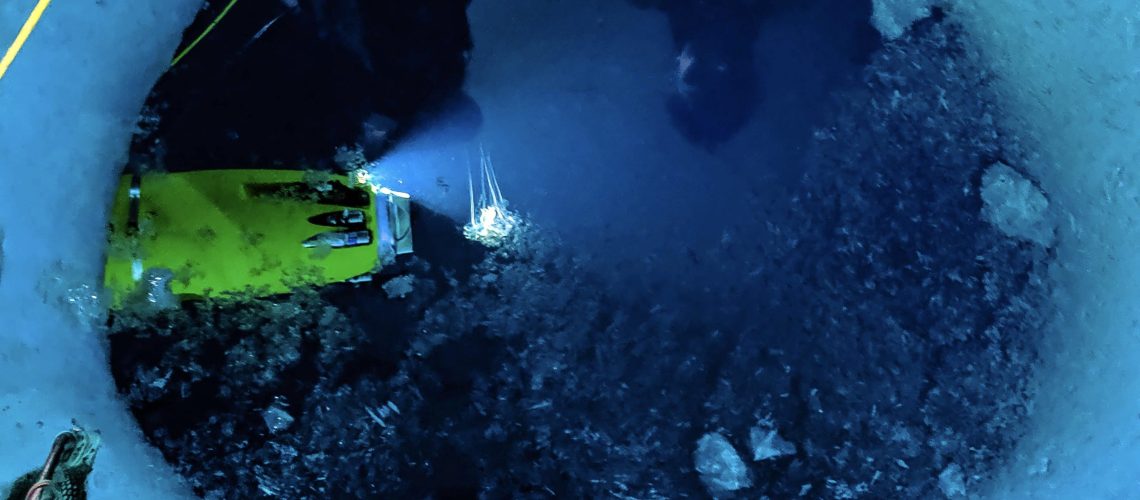Welcome to the Icefin Field Season 2019-2020! We’ve got an ambitious season ahead, involving two related Icefin projects: a continuation of the work from last season for B-041-NASA funded RISE UP project (PI Schmidt) in collaboration with Antarctica New Zealand’s Ross Ice Shelf Programme & Antarctic Ice Dynamics programs (Pis Hulbe & Horgan), and C-444 International Thwaites Glacier Collaboration Thwaites-Melt project (ITGC MELT, PIs Nicholls & Holland), funded through a collaboration between the UK NERC and the US NSF. We’re thrilled to be down here with two Icefin vehicles this year, prepping for dual grounding zone deployments in the December-January time frame at Kamb Ice Stream (B041) and Thwaites Glacier (C444). We’ll be updating you regularly on our progress from the field, at least as long as our access to emails allows!
Week 1 & 2: Oct 10 – Oct 27 2019
After much travelling and a few delays, the Icefin team is almost completely reunited down in McMurdo! Our first scouting team
composed of Ben Hurwitz, Andy Mullen, and Enrica Quartini arrived in McMurdo on Thursday 10/10, followed by Dan Dichek, Justin Lawrence, Britney Schmidt, and Peter Washam on 10/12, and finally Anthony Spears, following a rare boomerang flight on 10/20.


The first week was busy with training, team planning meetings, and sorting out equipment, including receiving a sleek new set of sturdy,
custom-made wooden boxes that were built for us by the Carp Shop over the winter to carry ICE03 modules to the sea ice — they’ll make a great second set next to the ICE02 ones! Our allocated Pisten Bully has been loaded with survival bags and drilling and rigging equipment and we also staged equipment on our sleds and more
equipment at the ice transition, ready to go. As of early last week, FS&T finished flagging a safe sea ice route to our main operations site (see Fig. 2) for the early season and the Fish Hut (our base of operations out on the ice — basically a rectangular wooden trailer-sized structure on skis with a hole in the bottom to access the ice and ocean — is out at the site and will be set with its dive hole tomorrow. We should have great pictures from that!


We’ve had some challenges with cargo. However, the Science Cargo team worked hard to address those, and luckily ICE03 traveled with the team (we continue to support Delta with our checked bag fees —33 this year!) on 10/10 and has since been successfully brought up and tested. We’ve completed a hybrid approach to ballasting the vehicle in the Crary lab test tank since we didn’t yet have our launch and recovery system (Fig. 4). Basically, Icefin is too long to fit in the 10’ tank here in the Crary lab. So, we created “stump-fin” by using a thruster module from ICE02 (which is shorter than the main electronics) and then added weight to it to match the displacement in water of the electronics.
This allowed us to do some first-order trimming of the vehicle prior to any dives to reduce the amount of work needed to get it floating properly. And sure enough, post-tank ballasting the vehicle trim was dead on and we were able to easily tweak it during our first dive and the Dive Jetty on Thursday (Fig. 5). The team worked extremely well and we were able to safely operate ICE03, conduct a series of engineering tests, and even get some footage of a fun encounter with a jelly fish along the way (Fig. 7)!
So really things are ramping up quickly and we are on a good and fast trajectory to becoming operational! The rest of our cargo arrived last week in time for the ANZ traverse to the Kamb Ice Stream camp. We’ve had meetings and contact with all of the work centers here at MCM that help our group: Mechanical Equipment Center (MEC), Field Safety & Training (FST), Berg Field Center (BFC, or basically the REI of MCM), Science Cargo, Fixed Wing (aircraft that will be flying us out to the field), and of course the Crary lab who always do such a great job helping out the science crew. We’ve had our first CTD cast and sampling run as well, so science is up and going!
Some other fun things have been going on as well. We played together as a trivia team last week (we didn’t win…go figure that a bunch of robot aficionados wouldn’t do all that well on the pop culture segments). We’ve attended science lectures on Seals and Penguins and Sea Spiders. Andy gave a fantastic science lecture to a full audience last Wednesday called “Adventures with Underwater Microscopes from the Tropics to the Poles.” Peter will be giving one this week on his Greenland work. Later in the season, we’ll give the main Sunday science lecture. We were honored to be picked as the featured science group in the station meeting last week, presented to the contractors and work centers by Dr. Karla Heidelberg, the main NSF representative on station.


Last Monday night, the team enjoyed participating in a conference call with the International Space Station. Almost everyone on station gathered in the Galley to have a chance to see the Earth from space in real time as astronaut Dr. Jessica Meir, a former student with the penguin biology group B-197 here on station, gave us a tour of the ISS and shared some of the views from the ISS glass dome. This week, we’re looking forward to getting ICE02 in the water and starting science operations!

This year the field team for Icefin consists of:
Britney Schmidt, Matt Meister, Dan Dichek, Anthony Spears, Justin Lawrence, Ben Hurwitz, Andy Mullen, Peter Washam, and Enrica Quartini.
RISE UP: https://live-schmidt-astro-cornell.pantheonsite.io/project-rise-up/
MELT: https://live-schmidt-astro-cornell.pantheonsite.io/thwaites-melt/
ITGC: https://thwaitesglacier.org
RISP: https://www.instagram.com/the_ross_ice_shelf_programme/
For more updates, pictures, and videos, find us on Facebook, Instagram, and Twitter @icefinrobot
